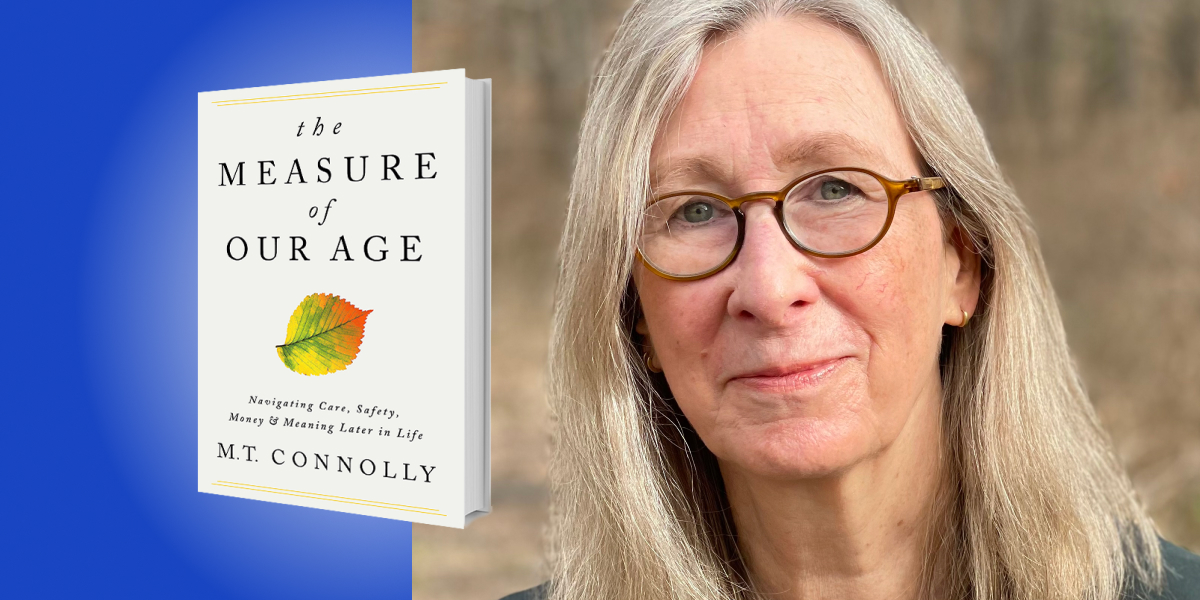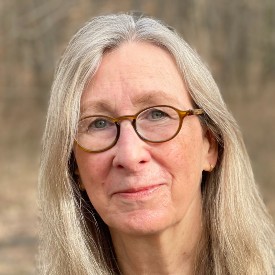MT Connolly is a leading national expert on elder justice who was awarded a MacArthur “genius” grant for her work that has shaped policy, research, and practice for decades. She was the architect of the federal Elder Justice Act, founding head of DOJ’s Elder Justice Initiative, and lead author of the Elder Justice Roadmap. That work, and what she learned from research for her book, The Measure of Our Age, led her to co-design the new community-based “RISE” model and to build teams that pilot more holistic, hopeful, and effective ways to reduce trouble and enhance connection in aging for individuals, families, and society. A graduate of Stanford University and Northeastern University School of Law, she lives in Washington, DC.
Below, M.T. shares 5 key insights from her new book, The Measure of Our Age: Navigating Care, Safety, Money and Meaning Later in Life. Listen to the audio version—read by M.T. herself—in the Next Big Idea App.

1. The Longevity Paradox helps us understand the complexities of aging.
We’ve achieved an astonishing victory in extending our lives, but we focus far more attention on adding years than on assuring that the years we’ve gained can be well-lived. That is referred to as the Longevity Paradox. We want to get old but not be old. The lopsided quantity-over-quality attention has real consequences for older people, for those who care about and for them, for society, and for the budgets of the social programs we all rely on.
It’s important to understand aging, both how hard and how good it can be. Unless we better understand it, we’ll continue to be unprepared for its challenges, miss out on the best parts, and lack the knowledge we need to improve our odds of a better old age, both in our own lives and as a society.
Some leading experts told me I had to pick a lane with my research and writing. But aging, like life itself, doesn’t respect lane markers. It veers all over the place from issue to issue. By looking closely at the challenges and connections among those issues, I’ve tried to map aging in a new way that will catalyze some long-overdue personal and policy conversations about longevity, provide strategies small and large to navigate its challenges, and help us focus more on the wondrous parts of being alive. Understanding the Longevity Paradox can help us face issues that urgently need our attention and will improve our lives.
2. Our care system is broken.
When my dad turned 90, we had a big party. He said he’d lived longer than anyone else in his family ever had in living memory. That’s true in lots of families these days. People 85 and older are the fastest-growing segment of the population, but we’ve extended our lives longer than our health. While our life expectancy is 78 years, our healthy life expectancy is only 66, and it’s lower still for people who are poor, poorly educated, and people of color.
Almost three in four people 85 and older have some functional disability. That means millions more people are going to need care. Most older people want to age in place—that is, get care at home. One thing that comes as a surprise to many people is that Medicare and most private health insurance plans don’t cover long-term care. It’s one of America’s biggest uninsured expenses. Many older people can’t afford care and want to avoid saddling their families with debt, so they impoverish themselves to qualify for Medicaid so that it covers their care, but this also comes with its own perils and fewer choices.
The upshot is that elder care is provided by family. The numbers are massive. More than 41 million people provide an average of 24 hours of informal or unpaid care every week for a person 50 or older over an average of four years. That’s more people than the entire population of California. That work can be very hard. Many of those caregivers look after people who are so sick that in the past they would have been cared for in hospitals and nursing homes.
“Medicare and most private health insurance plans don’t cover long-term care.”
Those informal caregivers’ mostly uncompensated services are valued at over $600 billion a year and are estimated to cost caregivers about $500 billion in lost income. Providing that care also leads to financial losses and health problems for caregivers themselves, like stress and heart disease. That causes downstream costs, considering that those caregivers are likely to die younger themselves.
All caregivers need more support. In particular, the financial burden of caregiving falls disproportionately on women and people of color. Its demands cause women to lose more money over the course of their careers, with their pensions being about half those of men, and undermine people of color from amassing generational wealth.
We also can’t look at family caregiving in a vacuum. Millions of people are terrified of facilities, especially nursing homes, and COVID only reinforced those fears. They’ll do almost anything to avoid them, even when they’re very sick. Staying home, however, means not having adequate care or the living situation is arduous for everyone involved.
There’s lots to say about nursing homes, but here are the main two points. We know that good staffing leads to better care, and we don’t know how nursing homes spend the almost $100 billion dollars of taxpayer money that they get a year. Specifically, we don’t know how much of it they spend on direct care for the benefit of residents. Assisted living is a $90 billion industry, and has even less oversight and accountability than nursing homes. Assisted living situations varies a lot from state to state. Consumers and policymakers alike need to have accurate, certified data about staffing numbers, how nursing homes spend taxpayer dollars and about who owns them.
There are many takeaways here. Families need to discuss care preferences and options earlier, so huge decisions aren’t made in crises. Family caregivers deserve and need better support. We also need to allocate the hundreds of billions of dollars we spend on long-term care better. Facilities should be held accountable for how they spend public funds. Finally, we need more quality, affordable, home and community-based services and support, which is what most people really want and need.
3. Aging increases financial vulnerability.
Money is a symbol that can take on a lot of subterranean meanings when it comes to aging. Parents may feel ashamed about relying on their kids. Adult kids may feel shame about relying on their parents. Siblings may disagree about supporting a parent and who should give what. Family members may feel entitled to take an older relative’s money, with justifications like, “I’ll get it anyway,” or, “I’ve earned it,” or, “I need it more.” They may also take it to feed a gambling, shopping, or drug habit. Older people, for their part, may think of money as a way to project status, settle grudges, punish behavior that they disapprove of, show love, or leave a legacy. Being alert to these subtexts can help us to troubleshoot and better understand what’s going on.
Aging also raises lots of practical questions relating to money. A good old age means thinking through how to make the money last. Most of our society’s focus is on how to get to retirement and less on how to get through retirement for those long, late chapters. We need to have those conversations much earlier. We also need more social support to encourage and guide us in doing so. Finally, we need more affordable and holistic financial planning options that take into account both means and meaning in how we allocate funds.
“Most of our society’s focus is on how to get to retirement and less on how to get through retirement for those long, late chapters.”
Our financial exploitation risk also rises as we age. Although 15 million older people live at or below the poverty line, older people are disproportionately wealthier than other age groups. Our longer lives mean that more people will experience cognitive declines that put them at higher risk for being exploited. Lots of predators are after older people’s money. Family members take, on average, twice as much per exploitation incident. Financial exploitation is very harmful to health and triples the rates of premature mortality in victims.
It’s crucial to have the money conversations early and to think about who you trust to name as Power of Attorney if your financial decision-making begins to decline. There’s a role for the financial industry in its regulators in protecting older clients too. For starters, it would help to invite older clients to name a trusted contact on accounts, like an emergency contact in the doctor’s office, to train staff to identify suspicious transactions. When they do identify them, the contact should empower them to freeze the account and make a report as appropriate. All brokers have implemented these protections, but the banks lag behind. So far, the Bank of America is the only major bank to have done so.
We also need to push policymakers in the financial industry to fund pilot tests to find more effective ways to prevent exploitation and to reduce the devastating harm it causes. For now, we usually wait until the money’s gone and then react. We need to focus more attention on prevention in both families and in society.
4. We need to learn how to navigate the autonomy-safety conundrum.
Many of us have had conversations or at least thoughts about when to encourage an older relative to stop driving. Similar questions come up with all kinds of other issues that we’ve thought less about. As adults, we’re entitled to make bad decisions. Some people experience brain changes that lead to riskier decisions in old age.
“What is our duty to respect a person’s autonomy, and when is the risk so high that our duty shifts and requires us to intervene?”
What if your recently-widowed father wants to give money to a new best friend or romantic caller, invest in some flaky investment, or live alone without help even though he’s leaving on the gas or has fallen several times? Many of us confront these questions. The big question is, what is our duty to respect a person’s autonomy, and when is the risk so high that our duty shifts and requires us to intervene? These are tremendously complex questions. We need to provide much more support and guidance for families in society about how to navigate these dilemmas respectfully and ethically.
5. We need to pay more attention to what matters most.
Our culture and our norms feed us a steady diet of messages that aging is bad and scary, and that we should feel ashamed of the changes that it brings. As a result, we carry around a lot of negative baggage relating to aging. This prejudice leads to harmful biases and is harmful to our own health and costly to our health systems.
The good news is that there are concrete ways to shift the needle from negative to positive, but it requires us to be intentional in doing so. Just a few examples include staying connected with people we love and even with people we know less well. Isolation and loneliness are terrible for our health. Staying connected is the cure.
We also should make sure that we have a sense of purpose. This is hugely important in old age, as it is throughout life. Older adults who volunteered with at-risk kids saw significant benefits in both mind and body. Old age also can be a time of curiosity, expanded consciousness, creativity, and an opportunity to invite awe into our lives in new ways, whether it’s walking in the woods or exploring new music. This too is very good for our health.
Writing about these subjects was a revelation for me. We have lots of unrealized control over how we live and how we spend our time.
To listen to the audio version read by author M.T. Connolly, download the Next Big Idea App today:































